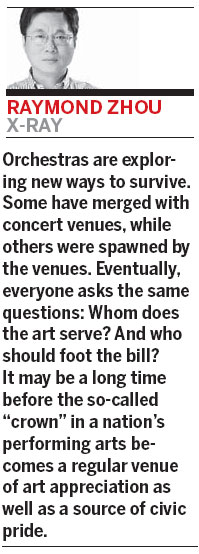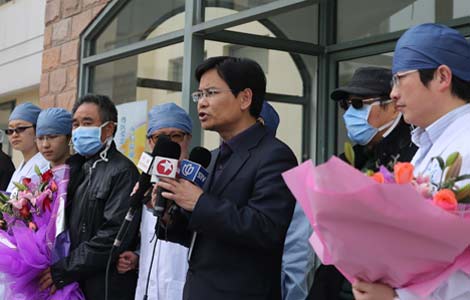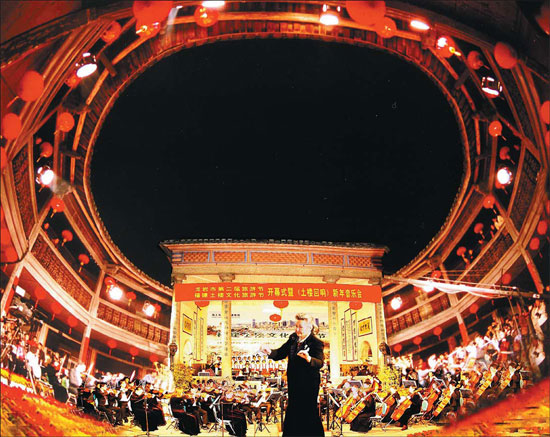Orchestras forced to play for their supper
Updated: 2013-04-20 07:18
By Raymond Zhou (China Daily)
|
||||||||
|
Zheng Xiaoying conducts the Xiamen Philharmonic Orchestra inside a tulou, the traditional abode for Hakka people. Like many of China's orchestras, hers reaches out to the public by presenting concerts close to where people live. Lin Mi / For China Daily |
Classical music may be on the rise in China, but orchestras are still struggling to find an audience. Whether they are used to add cultural depth to a municipality or educate the public about the beauty of art, they have to constantly prove their worth to both sponsors and the masses.
How do you add culture to a city? To some in China, a shortcut is to create a symphony orchestra. There are around 60 such orchestras across the nation, but their administrators are not celebrating. Instead, whenever they get a chance, they tend to launch a chorus of grumbling.
The cacophony of complaints lamenting a lack of government support and a shortage of paying audiences is in stark contrast with the mellifluous sounds produced by the grumblers. Yet, you cannot blame them. They live in an age when the State umbrella is folding, but the dark and rainy clouds have not yielded to a bright patch of sunlight.
The government's continuous efforts to push performing arts groups, including symphony orchestras, from the tight embrace of total State ownership into the wild and stormy sea of the free market is proving more difficult than expected. A Chinese city may be populous, but only a select few are ardent lovers of classical music. According to Cao Yiji, a manager with the Shanghai Philharmonic Orchestra, the city of Shanghai, with more than 20 million residents, has around 5,600 people who patronize 10 or more concerts a year while the Israeli city of Tel Aviv, with 3.4 million, has more than 20,000 loyal consumers of classical music.
As a result, revenue from paying audiences account for less than 10 percent of income for most Chinese orchestras. The largest sponsor is still government, even though they are technically no longer the "owners". Tan Lihua, music director of the Beijing Symphony Orchestra, emphasized the importance of "access to the top leaders" to obtain funding. Beijing spends 30 billion yuan ($4.8 billion) on culture each year, he said at the annual China Symphony Summit, held in Xiamen this week, and giving a few dozens of millions to a music organization is "peanuts".

"To become a giant of culture, we'll have to jump on the bandwagon of getting money from the government," he says.
A Chinese orchestra produces three kinds of concerts. The first is the season series, which more or less determines the artistic quality and the stature. "You have to present a regular season. If you're unable to play Mahler, go play Beethoven or Dvorak," says Tan, whose orchestra is among the top in the country, with 36 programs set for the 2012 season. The orchestra even commissions new works from Chinese composers.
By contrast, the Berlin Philharmonic has 90 sets in a season and gets half of its revenue from the box office, says Li Nan, president of the China Philharmonic. "Even if you have only 15 shows a season, you must do it. It is a hallmark of a professional orchestra," he says.
Li admits that things have been backtracking in recent years. What is supposed to be taken care of by the market is now once again a baby crying for food. Worse, the "parents", the government officials in charge, may have different opinions on the importance of a symphony orchestra. If the top managers of a city love classical music, you'll get more funds; if not, you may sink into a battle for survival.
The second kind of concert is for the public good. Musicians play in order to reach out to people who either do not have the purchasing power, or are simply not in the habit of going to a concert hall. Often subsidized by government departments, they serve as a tool of music appreciation for college students. But the system has a lot of problems. For example, the China Philharmonic is paid by the Ministry of Education to play 16 concerts a year, for which they are paid 80,000 yuan a show. But the money comes with strings attached. The concerts must be performed at colleges outside of Beijing. To offset the hefty traveling costs, the orchestra needs to shell out an additional million or more each year to maintain the program.
The Guangzhou Symphony Orchestra stopped touring college campuses in 2006. "The canteen or the gym is not the best place to introduce classical music to an emerging audience," says Chen Qing, the orchestra's deputy president. Instead, they started to invite students to the concert hall.
The third kind of performance is called commercial, which means a government or business organization acts as an institutional buyer. It pays a lump sum to the orchestra, who play to the staff, family and guests of the organization. Not everyone with a ticket will come, and those who do may not be the right audience. Orchestras are not proud of these gigs, but they will do them for the easy money. Often there is no need for rehearsal as the program is made up of light and fluffy tunes.
The ability to secure financing from either government agencies or corporate donors depends partly on how much these people with resources see classical music. Most view it as icing on the cake. There is the occasional success story of breaking out of the "either mayor or market" quandary. An orchestra in Inner Mongolia had a lucky break last year when an entrepreneur named Su Ri approached it. Su had learned to play the accordion while young. Later he turned to mining and made a fortune. When attending a concert in Beijing, he had an epiphany that children in his hometown should be exposed to this kind of musical enjoyment. He paid the orchestra 1 million yuan to tour schools deep in the prairie, performing 11 concerts. At each stop, he would provide further financial support to two of the poorest kids.
Orchestras are exploring new ways to survive. Some have merged with concert venues, while others were spawned by the venues. Eventually, everyone asks the same questions: Whom does the art serve? And who should foot the bill? It may be a long time before the so-called "crown" in a nation's performing arts becomes a regular venue of art appreciation as well as a source of civic pride.
Contact the writer at raymondzhou@chinadaily.com.cn.
(China Daily 04/20/2013 page18)

 Police: Bombing suspects planned more attacks
Police: Bombing suspects planned more attacks
 Premier: Rescue every person
Premier: Rescue every person
 Chinese soldiers clear mines, win hearts
Chinese soldiers clear mines, win hearts
 More bird flu patients discharged
More bird flu patients discharged
 Credibility still top concern for Chinese firms
Credibility still top concern for Chinese firms
 Every second counts in rescue
Every second counts in rescue
 Soldiers bring hope to earthquake-battered region
Soldiers bring hope to earthquake-battered region
 Chinese victims' families arrive in Boston
Chinese victims' families arrive in Boston
Most Viewed
Editor's Picks

|

|

|

|

|

|
Today's Top News
Investment patterns alter with times
Official promotes Beijing-Washington ties
Baoxing struggles to recover after quake
Chinese soldiers clear mines, win hearts
Intl scholarship puts China on the map
More bird flu patients discharged
Telecom workers restore links
Relief materials to reach quake zone
US Weekly

|

|







